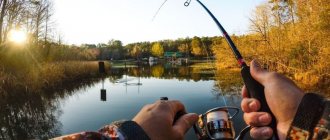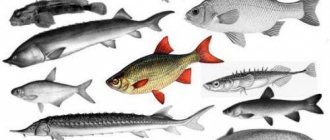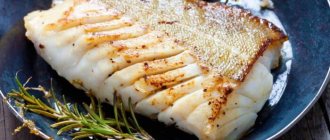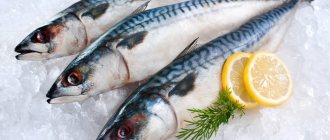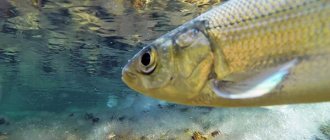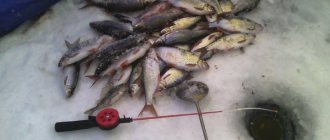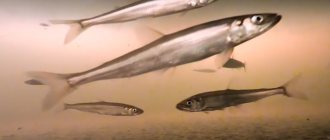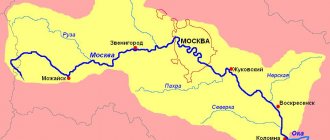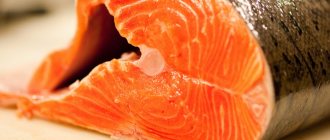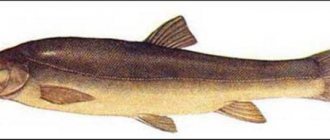Species composition of fish
The Volkhov River has a complex bottom topography and varying depths, which creates ideal conditions for the life and reproduction of many species of fish. The following fish species live in the river:
- pike,
- perch,
- som,
- zander,
- burbot,
- ide,
- bream,
- roach,
- silver bream,
- whitefish,
- blue,
- sopa.
To fish for predators in this reservoir, spinning or bottom tackle is usually used. Predatory fish are best caught on the river in September and October, when the water temperature drops to 7–9 degrees. With the arrival of autumn, all predators living in Volkhov begin to show increased activity.
Most anglers use classic bottom or feeder gear for fishing on the Volkhov
In the autumn months, pike weighing up to 5 kg are well caught. To catch it, you should use a fairly powerful spinning tackle, which will allow you to cast heavy jig heads and give you the opportunity to fight with large fish. In autumn, the predator responds better to large silicone vibrotails about 15 cm long.
Pike perch also becomes active with the arrival of September. This predator on the Volkhov should be caught near deep holes and under steep banks, where there is a sharp drop into the depths and trees washed away by the flood lie in the water.
Interesting! The river annually hosts competitions for catching trophy pike perch, which are called “Golden Spinner”.
Perch in this reservoir is active throughout the year. In the summer, it can be caught using a spinning rod and a float rod in the coastal zone, where the current slows down significantly. In autumn, perch moves away from the shore and stands in the area of the riverbed edge, from where it can be reached using a light spinning rod and a small jig bait. In winter, the “striped” one bites well on a jig and a balance beam. When moving along the Volkhov in winter, the fisherman must be extremely careful, since in many sections of the river there are ice-free ice holes.
With the first night frosts, a good burbot bite begins. This predator can be caught using bottom tackle, throwing bait onto the riverbed edge or places with sharp changes in depth. Burbot is much more willing to take the bait at night. A bunch of dung worms works better as bait.
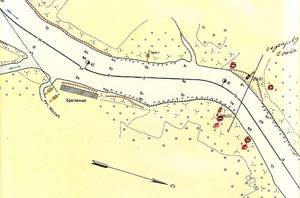
Map of the depths of the Volkhov River near the village of Bratovische
“White” fish are caught using a feeder and a Bolognese fishing rod. For ice fishing, a winter version of feeder gear is used. Despite the fact that peaceful fish are consistently caught on the river all year round, the most active bite begins with the arrival of spring.
Fishing in spring
Spring fishing for predators on the Volkhov is prohibited, so fishermen are forced to be content with fishing for peaceful fish. In spring, huge schools of various fish migrate along the river. While some species are just starting to spawn, others have already spawned and are ready to greedily peck at the offered bait. April and May are the most favorable times for fishing on this river. During this period the following are caught especially well:
- sopa,
- roach,
- silver bream,
- blue
Many fishermen come to this reservoir in the spring specifically to catch large sop. Representatives of this species grow here to record sizes. Sopa weighing 500 g is an ordinary trophy for this river. To fish for sopa, the fisherman will need to arm himself with Bolognese tackle, consisting of the following elements:
- Bolognese fishing rod about 7 m long;
- spinning reel size 3000;
- main monofilament line with a diameter of 0.16 mm;
- spindle-shaped float with a load capacity of 8 g;
- pear-shaped sliding sinker;
- swivel;
- leash 0.12 mm thick;
- hook No. 14.
Important! Particular attention should be paid to the length of the leash. The length of this element of equipment should be at least 80 cm, which will allow the bait to move more actively in the water column and better attract the attention of fish.
The float descent is adjusted so that the working depth of the equipment is 0.5–1 m higher than the actual depth at the fishing point. Such a setup of the tackle will allow for slow retrieval with the current, which is best suited for spring fishing for sop.
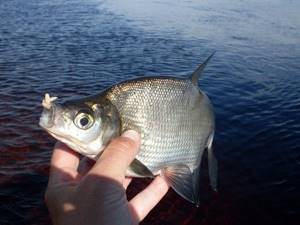
Sopa on Volkhov can be successfully caught not only with dung worms, but also with maggots
In spring, sopa bites better on dung worms. Even with an active bite, do not forget about regularly feeding the fish. Since the current on the Volkhov is quite strong in spring, heavy soil must be present in the bait. Along with sopa, other species of the carp family are also caught on the Bolognese tackle.
Where is the best place to fish in the river?
In Volkhov, fish are caught not only in summer, but also in winter. However, winter is considered unsafe, because there you can come across wormwood, which is created by warm springs. Despite this, there are many fans of winter fishing. In summer, fish are excellently caught on the current. A wonderful place to sit with a bottom fishing rod on the shore or on a boat. Near the Volkhov-Most station there is a great place for fishing. The river's tributary mouths also boast excellent catches. These estuaries include: Tigody, Oskuya, Keresti and Pchevzhi. Such places are considered the most catchy. But the fishing is better closer to the mouth of the Volkhov.
There are also not so tasty places for fishermen - the upper and middle reaches of the river. This is all connected with the Volkhov hydroelectric power station, which is located there. Because of the dam, fish cannot go from Ladoga to Volkhov. However, it cannot be said that there are no fish at all in the upper and middle reaches of the river. There are times when the bite is excellent.
Shore fishing spots
Excellent places for fishing from the shore are located near the Volkhov Most station. Here you can find a flat section of the coast and have good fishing with feeder gear. Here you can catch large roach, bream and bluegill on the feeder.
Closer to the bridge, significant depths begin next to the shore, which gives the angler the opportunity to fish with float gear. Near the bridge they are consistently biting on the float:
- bleak,
- roach,
- sopa,
- ide.
Fans of coastal spinning fishing should go to the Novaya Ladoga area, where they can successfully catch pike perch and large perch. Very fishing places are in Chudovo, where one of the tributaries of the Volkhov, the Kerest River, flows.
You can fish from the shore in the Volkhov region at the mouth of the Oskuya and Pchevzha rivers. There are also many places in the lower reaches of the Volkhov River where effective shore fishing is possible.
Many good places for fishing from the shore are located in the Chudovsky district near the village of Gruzino. The village is located right on the river bank, which leaves a certain imprint on the behavior of the local fish. Due to strong fishing pressure, local fish behave extremely carefully. However, these places constantly attract anglers, which is primarily due to the convenient access to the water. Spinning anglers catch pike and perch in this area. Feeders can count on catching large bream.
Village of Krenitsy
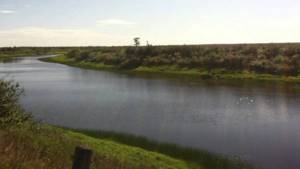
Another favorite place for fishermen is the river mouth near the village of Krenitsy. The city of Novaya Ladoga is also located nearby. There is a gentle current, a muddy bottom with a depth of up to 3.5 meters, and in some places there is a sandy shore. The river is navigable along its entire length. Mostly at the mouth of the river they catch perch, pike perch, silver bream, ide, roach, ruffe, sabrefish, asp, smelt, eel and so on. Typically, fishing here takes place on boats, however, there are those who like to fish with a feeder or donka.
The most important thing to remember is the stormy Lake Ladoga, as well as the dangerous squally wind. He is capable of turning over boats and boats. If we talk about bait, fishermen take a bunch of worms. Groundbait is also used successfully. Usually, they catch bream, bream, ide, silver bream and catfish. Some fishermen come to the mouth of the river for large specimens of catfish - up to 15 kg. It is better to catch them at night in deep holes.
But spinning fishing is still the most popular fishing. Trophy specimens of pike perch, pike, perch and other predators are found in huge quantities. If we talk about the size of the pikes that were caught here, they reached 14-15 kg. Acne is less common. Only few people know that in such a place you can still catch trout.
There is pike perch in small reaches, which also bite on wobblers, jig baits or regular silicone baits. But the best bait should be called a wobbler of neutral buoyancy. Usually, even pikes are caught on it, only pike perch bite more often. Fewer people come to such places for fishing in winter. In winter, they catch perch and roach, as well as ruffs and burbot, using bait and spoons. You should not go far from the coast in the spring, when the ice breaks off.
Catching catfish
Many fishermen come to Volkhov to catch catfish. The baleen predators in this body of water are not particularly large in size. The average weight of catfish caught on amateur gear is about 8 kg, but some fishermen managed to catch specimens weighing up to 20 kg.
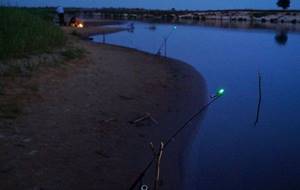
It is better to catch catfish on Volkhov at night
Catfish on the Volkhov are found in the deepest sections of the river. To catch it, the fisherman must know the bottom topography of the reservoir well and accurately cast the tackle. Catching catfish on this river is usually done using classic bottom tackle. The following are used as animal bait:
- frog;
- crawl out;
- a bunch of dung worms;
- live fish.
On a note! In autumn, small catfish often bite on spinning tackle equipped with jig bait. If the fisherman has a watercraft, then the chances of catching this predator with a spinning rod increase significantly.
Fishing on the Volkhov River is very diverse and will be of interest to those anglers who like to experiment and look for new approaches to fish.
Volkhov: fish and fishing
This river is a favorite place for many fishermen in the Leningrad region. Successful fishing in good places awaits even a beginner. You can use various tackle and bait on the Volkhov, since there is a wide variety of fish here: almost all species found in the European part of the country also live in the waters of this river.
Basic gear for fishing on the Volkhov River. Most fishermen use donks and feeders when fishing on the Volkhov, since in strong currents the float tackle has to be constantly rethrown. When fishing with a feeder, it is better to use a feeder weighing from 80 to 150 grams.
For spinning players, Volkhov is paradise and expanse. There are a lot of pike in the river and few hooks, which allows you to save the spoon. Often they fish with a spinning rod using a boat and using a motor, and then there is a chance to catch other more serious predators, such as asp, catfish, pike perch or chub. Wobblers, twisters and vibrotails are suitable as bait for spinning rods.
Shipping: yesterday and today
Volkhov is a navigable river along which dry cargo ships, boats, and pleasure boats move. The navigation period is 190 days.
Volkhov was part of the ancient trade route “from the Varangians to the Greeks” that went from the Baltic Sea to the Black Sea. Foreign merchants moved from the Neva to Lake Ladoga and back along the Volkhov. In the lower reaches of the river it was necessary to overcome the Pchevsky rapids near the village of Gorodishche, 8 km long, and the Gostinopolsky (Volkhovsky) rapids near the village of Novye Duboviki. The Volkhovsky ones were more dangerous: their length was 9.5 km, and the water drop was 10 m.
To overcome difficult areas, shipowners had to hire pilots - residents of villages located from Gostinopol to Duboviki. Back in 1269, the treaty of Novgorod with the Hanseatic League of Lübeck and Gotland mentions empty ships - Vorsch-Kerle, who were supposed to accompany the Hanseatic merchants along the river. Pilotage provided local residents with income.
In Ladoga, goods were loaded onto flat-bottomed ships. People landed at the rapids, and ships were pulled on ropes through dangerous areas.
During the time of Peter I, shipyards were founded at the mouths of the Syas and Volkhov rivers and the first ships were built. The Tsar ordered the construction of a canal from Volkhov to the Neva - now the ships, bypassing the troubled Lake Ladoga, reached the capital.
At the beginning of the 19th century, the first steamships appeared on the Volkhov. They served the construction of military settlements in the Novgorod province.
In 1857, the Volkhov Shipping Company was established, which owned passenger and cargo ships.
Until 1924, coastal communication was carried out by 5 steamship lines.
The seventies were the heyday of shipping on the Volkhov. Freight, fishing and passenger transport moved along the river. Residents of Novgorod purchased motor boats and boats.
Transportation volumes declined sharply in the 90s, and they have not yet been restored to their previous volumes.
Spinning fishing on the Volkhov River
The greatest interest among fishermen is fishing with spinning rods. By the way, the presence of a large number of predators in these places is really impressive. Fishing on Volkhov is famous for its catches of pike, pike perch, asp and perch. Well, if a catfish covets the bait, then we can assume that the time was not wasted. You can fish with bait both from the shore and from a boat. It is very effective to fish on the path. During the day you can catch small catfish and pike weighing up to 15 kg. And there are even eels on the straits. In many places, along the entire length of the river, on the reaches, there are pike perch in large numbers. It readily goes with both wobblers and silicone baits. This predator enters the waters of the river from Lake Ilmen, where pike and asp are also found. But it’s better to fish on the Volkhov itself and its tributaries. Asp can be found at the mouths of Oskuy, Kava, Kolpinka, Keresti and Pchevzha. They catch it with spinners and vibrating tails. The asp also reacts to medium wobblers. In general, it can be argued that along the entire length of the river you can find a large number of very catchy places. So no one will be left without, albeit not a very large, but still a trophy.
Tributaries
The Volkhov has 30 tributaries.
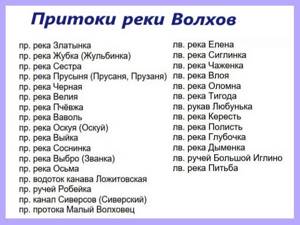
The main right tributaries are the Vishera, Pchevzha, Oskuya; left - Kerest, Tigoda, Olomna.
The length of Vishera is 64 km. The tributary flows into the Maly Volkhovets - the right branch of the Volkhov. The river is fed by peat bogs, so the water is bright brown.
Pchevzha carries water throughout the Novgorod and Leningrad regions. The length of the channel is 157 km. The width is up to 30 m. In the upper reaches the river is winding and narrow, and in the lower reaches it is deep and calm. Popular among rafting enthusiasts.
Oskuja is navigable. The length of the river is 114 km. Thanks to this river, the word “ushkuiniki” appeared, which in the distant past called Novgorod river robbers. They built their ships at the mouth of the Oskuya near Novgorod, and in the Novgorod dialect the name of the river sounded like Ushkuya.
Kerest flows from the swamps and flows into the Volkhov in the Chudovsky district. Its length is 100 km, its catchment area is 933 km².
Tigoda originates from the Tushinsky moss swamp. Length – 143 km, drainage area – 2290 km².
The Olomna flows through the Leningrad region. The length of the river is 52 km, the basin area is 420 km².
Fishing on Volkhov - video
Experienced fishermen will say that winter fishing is many times more exciting than in the warm summer season. And, in the end, hardening and physical activity have never harmed anyone. All fans of winter fishing on the Volkhov River will also not be disappointed, but do not forget that in the regions of Novgorod there are many warm springs that form polynyas. The Volkhov is covered with ice at the end of November, and ice drift begins in mid-April.
In the spring, with the first rays of the hot sun, when the hungry pike begins to eat and begins to take any bait, this is simply a golden time for spinning fishing for fishermen who miss good fishing.
There are many fishing and recreation centers on the banks of the Volkhov. At the bases you can rent any fishing equipment or boat.
In any case, you are a fisherman or you just came to take a break from the hustle and bustle that has constantly surrounded us lately; when you come on vacation to the Volkhov River, you will enjoy the magnificent scenery, peace and tranquility.
Successful fishing on the Volkhov River and a wonderful mood awaits everyone who visits these places.
What kind of fish can you catch in Volkhov?
For fishermen, the reservoir is a favorite place due to the variety and quantity of fish.
Here you can catch the following types of underwater inhabitants:
- pike. Catching this species is the most common. From the shore you can catch small specimens weighing 500 grams, but not more than two kilograms. Large fish are found in the depths. According to reviews from successful fishermen, the largest pike caught weighed 15 kilograms;
- bream When fishing, use a bottom fishing rod. Its average weight is 5 kilograms;
- perch It is well caught in the summer, and leaves for spawning in the spring;
- guster. The fish is small in size and weight. It lives in schools and is caught using bottom tackle;
- burbot. Refers to predators. It differs from the Siberian species in its low weight.
This list is not exhaustive. Volkhov is also inhabited by: eel, crucian carp, whitefish, loach, ide, asp.
Description of the Volkhov River
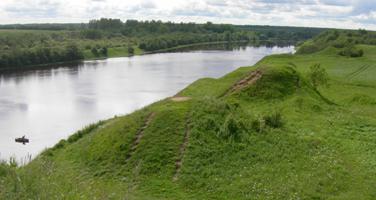
The Volkhov River is located in the northwestern part of Russia. Its source is Lake Ilmen. The main tributaries are Pchevzha and Oskuya. Having completed a journey of 224 kilometers, the waters of the Volkhov River flow into the famous Lake Ladoga. This relatively small river can be called unique. Its waters can change direction of flow. How can this be? The thing is that the difference in heights between the source and the mouth of the river is not too great and when there are changes, the water turns back. This is how the Volkhov changes the direction of its flow. On the banks of this river are the cities of Novgorod, Novaya Ladoga, and Kirishi. Shipping is very developed here. The width of the river in the Novgorod region is approximately 220 meters. Well, of course, fishing on the Volkhov deserves special attention. The river has long been famous for its fishing routes. By the way, you can successfully catch fish here almost everywhere. The hooks include pike, asp, pike perch, burbot, catfish, perch, silver bream, bream, whitefish, bluegill, sabrefish, bleak and ruff. So no one will be left without a catch.
Free fishing in the Novgorod region
The Novgorod land is the cradle of the Russian state, glorified by warriors and rich from trade. It is famous for its rich fish stocks and abundance of various water systems, clean air, beautiful nature and silence. To return with a good catch, you need to know everything about fishing in Veliky Novgorod and the Novgorod region.
Here are the TOP 10 best places where you can fish for free in the Novgorod region:
1. Lovat River
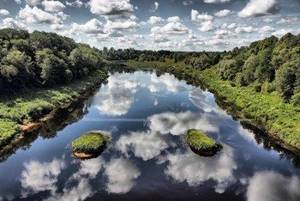
Description, what kind of fish is found, how to get there:
The source of the river is in the Belarusian Lake Lovatets. At the confluence with the lake. Ilmen forms a delta of more than 400 square meters. km. The total length is 530 km. Lovat is the largest river in the Ilmen region. There are only two large settlements on the river - Velikiye Luki and Kholm. Many different tributaries.
The most common fish: catfish, ide, pike up to 15 kg, grayling, asp, pike perch over 2 kg, perch up to 1 kg, bream up to 4 kg, roach, bleak.
They catch fish using almost all methods - donkeys, spinning, fly fishing, float rods. Winter fishing is especially productive.
GPS coordinates: 57.65824, 31.48527
2. Volkhov River
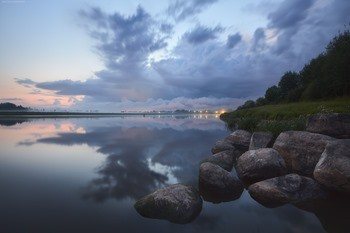
Description, what kind of fish is found, how to get there:
The only one flowing out of the lake. Ilmen river. Connects Ilmen and Lake Ladoga. The river is navigable. Length – 224 km. The width near Novgorod is 220 m. The average depth is 4-5 meters, the greatest is 12 meters. It is blocked by a hydroelectric power station, which negatively affects fishing in the upper and middle reaches. The best bite is observed in the lower reaches, where fish freely enter from Lake Ladoga. The Volkhov has many large and small tributaries. Due to the small height difference, it sometimes changes the direction of its flow to the opposite.
The most common fish: catfish, ide, pike up to 15 kg, grayling, brook trout, salmon, barbel, asp, pike perch, perch up to 2 kg, bream up to 6 kg, silver bream up to 1.3 kg, chub, sabrefish, roach, whitefish up to 3 kg, smelt, lamprey, gudgeon, dace, crucian carp, burbot, eel, ruff.
Good fishing both in summer and winter. In winter, there is a danger of falling through the ice in places where warm springs flow.
Excellent places for fishing for donka and feeder at the mouths of inflowing rivers. Feeders are used weighing 80 - 150 g.
When fishing with spinning rods and fishing rods, any bait can be successfully used.
GPS coordinates: 59.29138, 31.85486
3. Kunya River
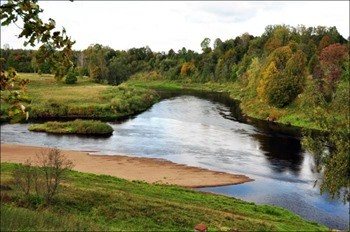
Description, what kind of fish is found, how to get there:
Lovat tributary. It has two of its own tributaries, replete with riffles and very shallow in summer - the Bolshaya and Malaya Tudera. It winds strongly in the upper section. Beyond the mouth of the river. Usvyaty – many rapids and rifts. Chub and trout are found in the tributaries.
The most common fish: redfish, perch, pike, roach.
Almost all the fish that live in Lovat are caught.
4. Msta River

Description, what kind of fish is found, how to get there:
The source is Lake Mstino in the Kalinin region. At the confluence with the lake. Ilmen forms a delta in which a huge amount of bream accumulates. More than 50 rapids, many tributaries. Clean banks with mixed forest, not littered with household waste.
The most common fish: silver bream, pike, roach, chub, perch, pike perch, catfish, carp.
Most often, bream within the delta are caught on donks and feeders at the end and beginning of the dumps. It is believed that sterlet lives in Msta.
GPS coordinates: 58.52202, 31.71241
Lake Ilmen
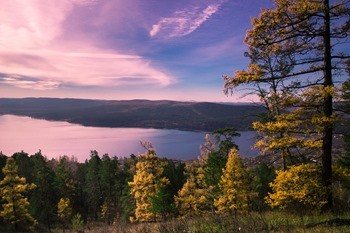
Description, what kind of fish is found, how to get there:
Located in the west of the region. The area of the water surface depends on the water level and ranges from 733 to 2090 square meters. km. Approximate width 35 km, length 45 km. The depth reaches 10 m. The water drop can reach up to 7 meters. The nature of the shores is varied, there are rocky ridges, swamps and floodplains. More than 50 rivers flow into the lake, only the Volkhov flows out. Many organic substances give the water a yellowish color.
The lake is home to 26 species of fish. The most numerous inhabitant is considered to be smelt. There are a lot of trophy perch, the best time to catch them is winter. A limit has been introduced on the catch of bream, pike perch and pike.
The most common fish: pike, bream, pike perch, smelt, carp, burbot, perch.
The presence of a large amount of natural food causes the rapid growth of fish.
GPS coordinates: 58.24652, 31.27236
Lake Seliger
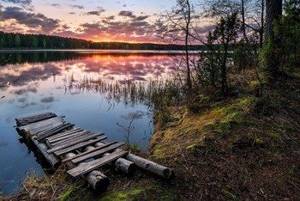
Description, what kind of fish is found, how to get there:
It consists of several lakes connected by channels. The northern part of the lake system is located in the southeast of the region, the rest in the Tver region. The water is clear and clean. The coastline is indented with capes and bays. There are 30 species of fish.
The most common fish: pike, bream, pike perch, 2 types of vendace - small and large, perch, burbot, ide, roach, carp.
GPS coordinates: 57.4923, 33.02589
Lake Valdai
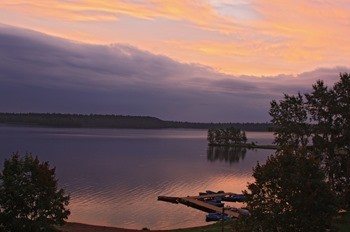
Description, what kind of fish is found, how to get there:
The second name is Valdai. It is one of the ten cleanest lakes in the world. The area without islands is 19.7 sq. km. Average depth – 12 m, maximum – 60 m. Length – 10 km, width 5 km. Divided into two parts by Ryabinovy Island. There are three large islands and many small ones on the lake.
The most common fish: pike, bream, roach, carp, tench, perch, burbot.
Most often people catch here using spinning rods, circles, donks, winter girders, etc.
GPS coordinates: 57.98973, 33.27216
8. Lake Velje

Description, what kind of fish is found, how to get there:
The lake has sandy shores and bottom. The water level is artificially raised by the dam. Depth differences can be up to 42 m. There are many islands on Velha. It is difficult to get to the lake. You can catch carp, pike, pike perch, bream, and perch. The water in the lake is so clean that it is suitable for drinking. There are no industrial enterprises or agricultural producers nearby.
GPS coordinates: 57.67562, 33.00013
Lake Gorodno
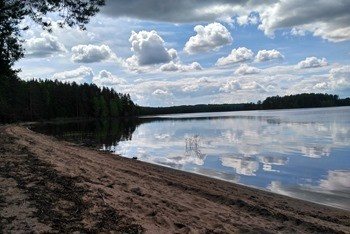
Description, what kind of fish is found, how to get there:
The unique lake is located on the territory of a state reserve. Lake Gorodno is of karst origin. For this reason, once every 20–40 years, the water completely disappears from the lake. The bottom, covered with silt, becomes an excellent pasture for livestock. The water in the lake is clean, which attracts fishermen to these places.
GPS coordinates: 58.83297, 33.91933
Lake Meglino
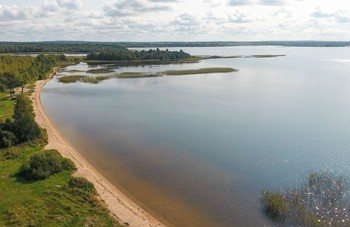
Description, what kind of fish is found, how to get there:
Lake Meglino is located in the south-eastern part of the region. The average depth is 7 m. The bottom is sandy, with occasional stones. A good catch here is guaranteed at any time of the year. Beautiful places attract fishermen and tourists from neighboring regions. They get to the lake by public or private transport. Local fishermen come on foot.
GPS coordinates: 58.41543, 35.11419
Do you know any other good places for fishing in the Novgorod region - write in the comments
